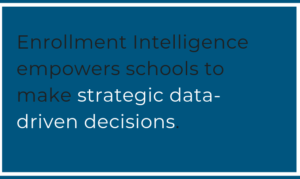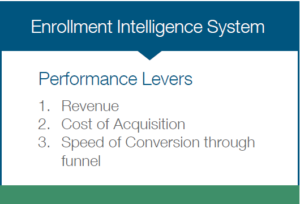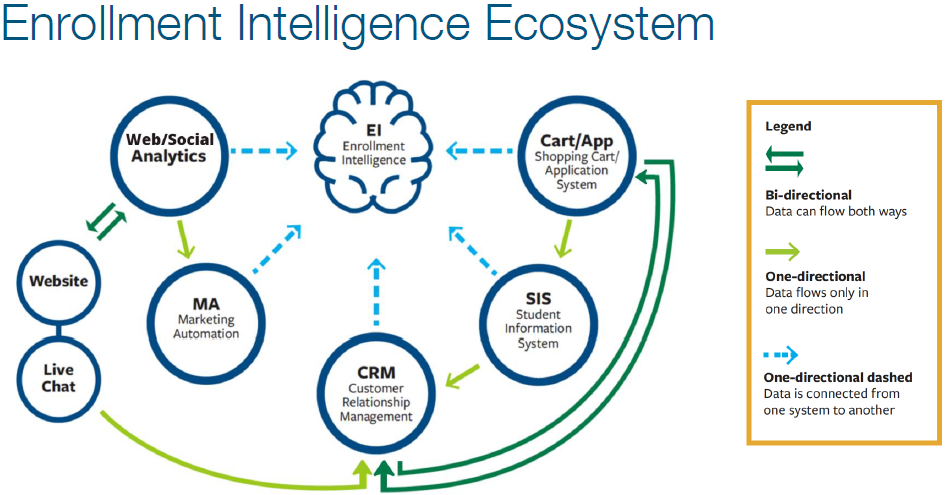Using Data-Driven Insights to Increase Enrollments
Better data means better insights – and outcomes
As enrollments continue to decline, it becomes even more critical to understand the student journey through the enrollment funnel. Effective enrollment data reporting is a critical first step to understanding that journey. Unfortunately, marketing and enrollment data is not always available, or the data comes from multiple sources. This makes it difficult to connect the data to formulate insights that illustrate which marketing strategies are effective and the success rate of converting a lead into an enrollment.
Why are “incomplete” enrollment reports a problem?
Incomplete information creates silos between disparate systems forcing the marketing team to rely on inference (instead of actual data correlations or causations) to make determinations. There are many layers to the data from various systems and if the data cannot be connected in real time, the marketing team cannot measure how effectively their marketing strategies are influencing leads and enrollments.
What should you measure?
There are three components that enrollment reports should measure:
- Revenue/enrollment
- Cost of acquisition
- Speed of conversion
Analyzing the number of enrollments over a specified time period and ideally measuring month-over-month and year-over-year numbers will provide high-level insights. For example, measure Q1 of 2018 against Q1 of 2019 so you have some reference points and can see performance over time.
Cost of acquisition is an important metric to use to understand the performance of marketing strategies. The key is to know the optimal cost of acquisition for the type of program you are trying to grow or introduce into a new market. Knowing the optimal cost of acquisition provides context on how a program is performing against the market.
Speed of conversion is an important metric used to describe the student’s journey through the enrollment funnel. Understanding the time it takes for students to decide about enrolling in a program helps to map out the timing of certain marketing tactics. This helps schools understand the predictability of prospective students’ behavior throughout the funnel.
Roadblocks to full-funnel enrollment reporting
In working with institutions nationwide for several decades, we’ve uncovered four major challenges in producing a full-funnel enrollment report.
- Challenge #1: Important data is often limited or inaccessible. Often, schools don’t have access to all their data. They may have access to enrollments. They may have access to web analytics, but they may not have access to leads or know about the visitors to their website.
- Challenge #2: Technology ecosystems are incomplete. Technology might not be fully built out. Schools might have a CRM, but no marketing automation. They may not be utilizing the full features of a system or have an all-in-one system that isn’t performing as well or as thoroughly as it should be.
- Challenge #3: Technology ecosystems are disconnected. Systems simply aren’t connected. If a CRM is not connected to the Student Information System, reporting isn’t happening in real-time. For example, many schools “run a report” every two weeks or so and share it with the marketing team. This means that the data is outdated by the time the team sees it.
- Challenge #4: Technology ecosystems are connected but do not provide insights. Systems are connected, but schools are not using the data. Insights are hard to extract from the data, therefore, there is no action being taken to optimize their marketing and enrollment efforts.
It’s impossible to create a holistic picture of all the different activities and influences of various marketing efforts and returns on your investment if you don’t have the systems in place and connected.
How to overcome challenges
Enrollment intelligence is a full-funnel view of how prospective students experience an institution, how they engage throughout that process and what happens as they enroll.
Fully built out, Enrollment Intelligence looks like this:
Some systems communicate in only one way and others take information in and push information out. Establishing the right communication flow between systems is key.
Why Enrollment Intelligence is Important
Schools will have integrated data with all systems synced making it easier to see and understand the entire student lifecycle.  With information brought out of silos and centralized, you can visualize the data and easily get the answers you need. Lastly, with the right data and analysis in place, you can gain powerful insights about enrollment trends. This will lead to better decisions on how to maximize your investments and resources.
With information brought out of silos and centralized, you can visualize the data and easily get the answers you need. Lastly, with the right data and analysis in place, you can gain powerful insights about enrollment trends. This will lead to better decisions on how to maximize your investments and resources.
Takeaway
Strive for enrollment intelligence by integrating and centralizing your marketing and enrollment data. It will help you understand where your marketing investments are going, what your ROI is, and where you need to adjust. A future blog post will expand on this topic. Make sure you sign up to receive notifications when it’s posted.
In the meantime, watch a complimentary on-demand webinar to learn how you can increase enrollment through data-driven insights.
Related Ideas
Will OPMs Adapt to Meet Evolving Demands in Higher Education?




